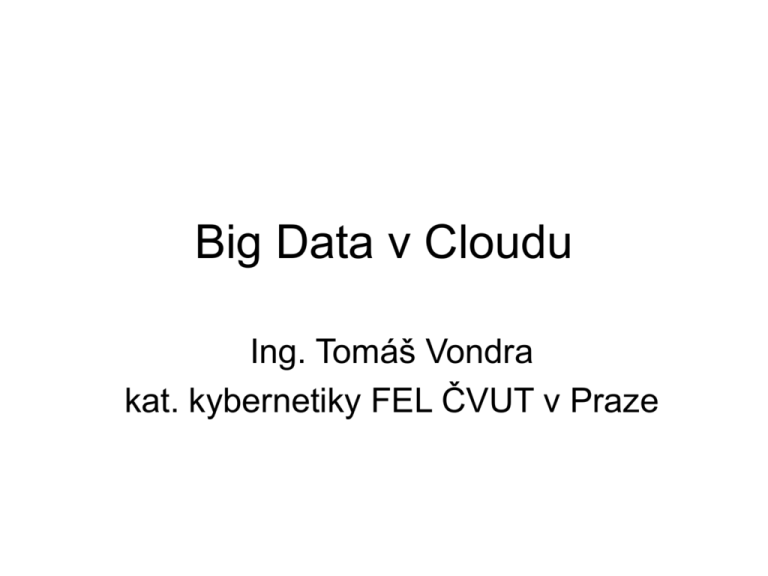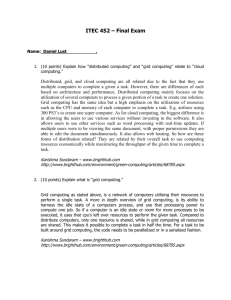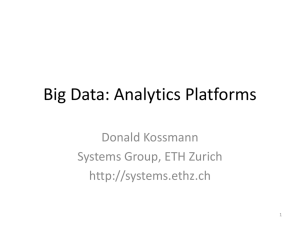Big Data v Cloudu
advertisement

Big Data v Cloudu
Ing. Tomáš Vondra
kat. kybernetiky FEL ČVUT v Praze
Úvod
•
•
•
•
Skupina Cloud Computing Center
eClub: Enterpreneurs’ Club
Summer Camp
Předměty
– Technologie pro velká data
– Vývoj internetových aplikací
Cloud Computing Center
•
•
•
•
Malá výzkumná skupina
Vedoucí: Ing. Jan Šedivý, CSc.
6 doktorandů
V tomto období nejisté množství diplomantů a
bakalářů
Cloud Computing Center
•
•
•
•
Cíl: aplikovaný výzkum, spolupráce s průmyslem, výuka
Firmy: Cloud Computing, Machine learning, Big Data
Univerzita: algoritmy deskriptivní a prediktivní analýzy
Příklady projektů:
–
–
–
–
–
–
–
–
Kontextuální reklama založená na topic modelu
Rozpoznávání jmen a označení firem ve větě
Modelování chování hráčů on-line her
Generování synonym pro vyhledávání
Klasifikace spamu a vyžádaných newsletterů
Předpověď vytížení cloudu pomocí časových řad
Deployment aplikací do cloudu řízený performance modelem
Škálování Hadoopu v cloudu
Enterpreneurs’ club
• Podpora studentských podnikatelských
nápadů
• Přednášky o soft skills, příběhy firem
– Přednášky streamujeme do dalších škol
• Studenti tvoří týmy, dělají prezentace
• Na konci soutěž o stipendium
– Stáž v inkubátoru v Silicon Valley
– V porotě také investoři
Summer Camp
• Tentokrát nebyl zaměřen jen na startupy
• Projekty zadané partnery
– Pro studenty stipendia (dokončilo asi 16)
– Témata:
•
•
•
•
•
Automatický překlad Twitteru (UFAL MFF UK)
Cloud Computing
Škálovatelné prediktivní modely
Uživatelská rozhraní pro tablety v autě
Automatické hraní her (Atari, Angry Birds)
Předmět Big Data
• Volitelný předmět v letním semestru
• Kapacita 40, poprvé přihlášeno 28
• Schvalování bylo kontroverzní
– Prý je zaměření příliš průmyslové
– Podle nás je praxe na univerzitě důlžitá
• Definici Big Data uvádět raději nebudu
– Nestrukturovaná data nebo
– Velký objem nebo
– Rychle přibývající záznamy
Předmět Big Data
• Učitelé: Jan Šedivý, Tomáš Vondra, Tomáš
Tunys, Ondřej Pluskal, Martin Pavlík (IBM)
• Cíl: naučit studenty aplikovat algoritmy
• Platforma: Hadoop (distr. IBM BigInsights)
• Zvolená data: Obsah české Wikipedie
– Objem jen 1 GB, ale jsou nestrukturovaná
• Hardware: virtuální servery v cloudu TC Písek
– Do dvojice studentů cluster 3 strojů
• Celkem včetně testovací instance 45 VM
• Fyzicky spuštěno na 2 serverech
BDT: Program přednášek
•
•
•
•
Cloud computing a platforma OpenStack
Hadoop a jeho komponenty
Paralelní programování a limitace Hadoopu
Programování v Map-Reduce
– Implementace TF-IDF
• HDFS a databáze Hive a HBase
– Paralelní souborové systémy a administrace HDFS
• Knihovna Mahout
– Implementace clusterování k-Means
• Streaming data pomocí Apache Storm
– Cvíčení na Storm
HDFS – Hadoop Distributed File System
• File System where
o Hadoop components and
applications expect their
data
File1
a
b
c
d
Name
Node
• Links together subsets of FS
on nodes in cluster
o => brings new big virtual
File System
• Uses Master / Slave
architecture
a
b
d
b
a
c
a
d
c
DataNodes
c
b
d
HDFS – Write example
B B2 B3
1
NameNode
Data never flows through
NameNode
DataNodeR1N1
DataNodeR2N1
Name node communication
DataNodeR1N2
DataNodeR2N2
Data send from client (from
DataNodes to next
DataNodes in the pipeline
DataNodeR1N3
DataNodeR2N3
ACK of successful write of
packet (typically 64kB)
DataNodeR1N4
DataNodeR2N4
ACK of successful write of
a block (typically 64MB)
DataNodeR1N5
DataNodeR2N5
DataNodeR1N6
DataNodeR2N6
DataNodeR1N7
DataNodeR2N7
DataNodeR1N8
DataNodeR2N8
MapReduce - explained
• Data stored in HDFS spanning inexpensive computers
• Bring algorithms to data
• Distribute application to the compute resources where
Hadoop Data Nodes
the data is stored
1. Map Phase(break job
public static class TokenizerMapper
extends Mapper<Object,Text,Text,IntWritable> {
private final static IntWritable
one = new IntWritable(1);
private Text word = new Text();
public void map(Object key, Text val, Context
StringTokenizer itr =
new StringTokenizer(val.toString());
while (itr.hasMoreTokens()) {
word.set(itr.nextToken());
context.write(word, one);
}
}
into small parts)
Distribute map
tasks to cluster
}
all output down to
a single result set)
public void reduce(Text key,
Iterable<IntWritable> val, Context context){
int sum = 0;
for (IntWritable v : val) {
sum += v.get();
Shuffle
Result Set
output
for final processing)
3. Reduce Phase(boil
public static class IntSumReducer
extends Reducer<Text,IntWritable,Text,IntWrita
private IntWritable result = new IntWritable();
. . .
2. Shuffle(transfer interim
Return a single result set
Parallel Reduce / Divide and Conquer
●
●
Parallel search on CRCW-concurrent
o Read x, search for x in n/p, write 1 if found
What about EREW PRAM?
o Read using parallel distribution (only 1 input)
o Write using parallel reduce (to get 1 result)
Both have O(log p) -> O(n/p+2log p)
Map-Reduce in Hadoop
●
Not classical map and reduce
o Uses the divide and conquer approach
o But no reduction trees - only two levels
o The single communication phase is managed
o Works with files or blocks of fixed size
WordCount algorithm
Document representation
•A dataset of documents: corpus.
•How documents can be represented?
●Each language has a more-less fixed vocabulary.
●Is order of words in text significant?
●How many different words are present in one document?
Vocabulary : how to build it?
● Should have the least amount of words, but most
representative!
● Stop words? (a, the, or)
● Rare words?
● Advanced:
o Lemmatization
o Stemming
o Part of speech tagging
TF-IDF : The Idea
● Does the length of the document matter?
o TF = term frequency
● If we have some word in every document (e.g. word
“love” in a corpus of romantic novels) does is it give
enough information?
o IDF = inverse document frequency
Homework Assignment:
1. Clean data and create vocabulary.
2. Create tf-idf from Wikipedia in sparse matrix
representation.
CAP theorem - CA / noSQL (CP + AP)
Hive
•
•
•
•
Framework for data-warehousing in Hadoop
Enable to run SQL queries on top of huge volumes of data
stored in HDFS
o HiveQL - SQL dialect used on top of Hive
Data are organized into tables
Table creation
CREATE TABLE records (year STRING, temperature INT,
quality INT)
ROW FORMAT DELIMITED FIELDS TERMINATED BY '\t';
•
Table population (no parsing, just copy / move to managed
location on HDFS)
LOAD DATA LOCAL INPATH 'input/ncdc/micro-tab/sample.txt'
OVERWRITE INTO TABLE records;
HBase - data model - columns
•
•
•
•
•
•
Row columns are grouped to column families
All columns names has the following syntax:
o <col-fm-prefix>:<qualifying-tail>, e.g:
▪ temperature:air, temperature:dew_point
Column families
o has to be defined with the table up-front
o members are stored in the file system together
Columns
o can be defined and used on demand
HBase is column-family store oriented
Comparison of the model to RDBMS:
o Cells are versioned
o Rows are sorted according to row-key
o Columns can be added on the fly if family exists
Scalability, Tuning 1
●
Local node optimization
o Balance CPUs and RAM, don’t let it swap
o Each system process and map/reduce is JVM
-Xmx=1000M is default
o The processes are mostly single-threaded (with asynchronous
I/O), so 1 map per CPU
mapred.tasktracker.map.tasks.maximum
Most examples set reduce.tasks.maximum to half this
number
●
All may be running at once!
o Don’t forget the system process overhead
Slaves: Just DataNode and TaskTracker
Master: A lot of them :-)
CPU to disk ratio: 1 disk per 1 to 2 CPUs
Hadoop on cloud 1
●
●
●
Advantages:
o Fast deployment of Big Data infrastructure
o Sharing of servers with other tasks
Increased utilization
Disadvantages:
o Virtualization overhead
1s of % on CPU, 2 schedulers defeat Amdahl
It is present in 10s of % on disk and net
Specialties:
o add and remove nodes based on actual usage
core datanodes and temp. tasktrackers
o Elastic MapReduce / Elastic Data Processing
launch a cluster just for a single task
Hadoop on cloud 2
●
Problems:
o Data redundancy. Replicas on different VMs may end on the
same physical disk
VMware: Hadoop Virtualization Extensions, in Hadoop 1.2
and 2.1+
o Data persistence. VMs are temporary
Use persistent disks - may be on a separate array
Use cloud’s own filesystem, not HDFS, -”●
Amazon S3, OpenStack Swift
Use suspend function
Use the physical machine as DataNode?
o Impact on disk and net for other tenants?
Hadoop on cloud 3
● Implementations:
o Public:
Amazon Elastic MapReduce
Microsoft HDInsight
Rackspace Big Data Platform
o Private
VMware Serengeti -> Big Data Extensions
OpenStack Savanna
o This list is not exhaustive. There are and will be
more providers.
Lloyd's k-Means Algorithm
● Works in 2 steps (+ initialization):
o Initialization: Pick randomly K samples from
dataset which become the initial cluster centroids.
o Assignment: For each data vector find the nearest
centroid and assign the vector to its corresponding
cluster.
o Refinement: Recalculate the cluster centroids as
the means of the data vectors within their
corresponding clusters.
● When do we stop?
o Threshold for the maximum number of iterations.
o Use the detla rule - If nothing moves much, halt!
Assignment
Refinement
Assignment
Terminate
Machine Learning
S4
Storm
SAMOA
Batch
Processing
minutes to hours
real time
Stream
Processing
Spark
Hadoop
MLib
Mahout
Hadoop
● slow due to I/O operations
Spark
Storm
● oriented graph
• Terminology: Sprouts, Streams, Bolts
Vývoj internetových aplikací
•
•
•
•
Volitelný předmět v zimním semestru
Kapacita 40, 4.rok a přihlášeno 37
Rovněž praktický předmět
Zaměřeno na propojení cloudu a mobilní
aplikace (ideálně i s Big Data)
• Některé technologie studenti vidí poprvé
• OpenStack, Android, SQLite, REST
– Jiné již znají z ostatních předmětů
• Java, servlety, JSON
Vývoj internetových aplikací
• Učitelé: Jan Šedivý, Filip Kolařík, Radek Pospíšil (HP),
Tomáš Bařina, Tomáš Tunys, Tomáš Vondra
• Cíl: napsat mobilní aplikaci s cloudovým backendem
• Platforma: Samsung Galaxy a OpenStack
• Forma: Týmový projekt po 4-5 lidech
– Zadání vymýšlí studenti sami
• Hardware: zatím neznámo - během let se měnil
– Nejdříve Google App Engine, pak Eucalyptus, minule OpenStack
na nevyhovujícím kancelářském HW
• Každému týmu tu stačí jeden až dva VM s 0,5 GB RAM
– Doufáme v další spolupráci s TC Písek
VIA: Program přednášek
• Platforma Android
– Programování pro Android
• Architektura REST
– Jak napsat REST v Javě
• Od hostingu ke cloudu
– Praktické příklady cloudových služeb
• Cloud Computing a OpenStack
– Spusťte si vlastní server
• Komunikace v Androidu
• Databáze MySQL
– SQLite v Androidu
• Performance engineering a load testing
• Bezpečnost webových aplikací







